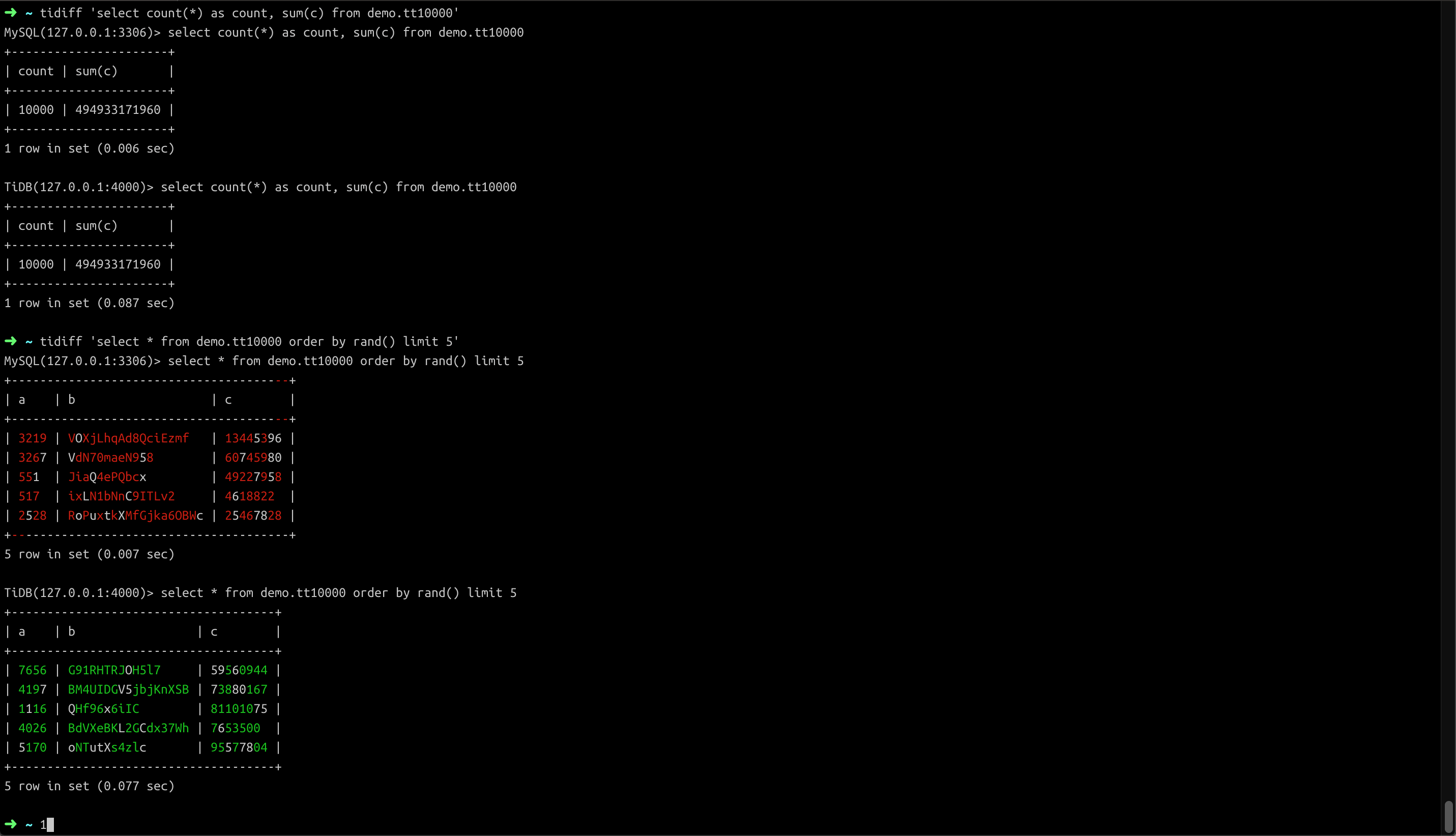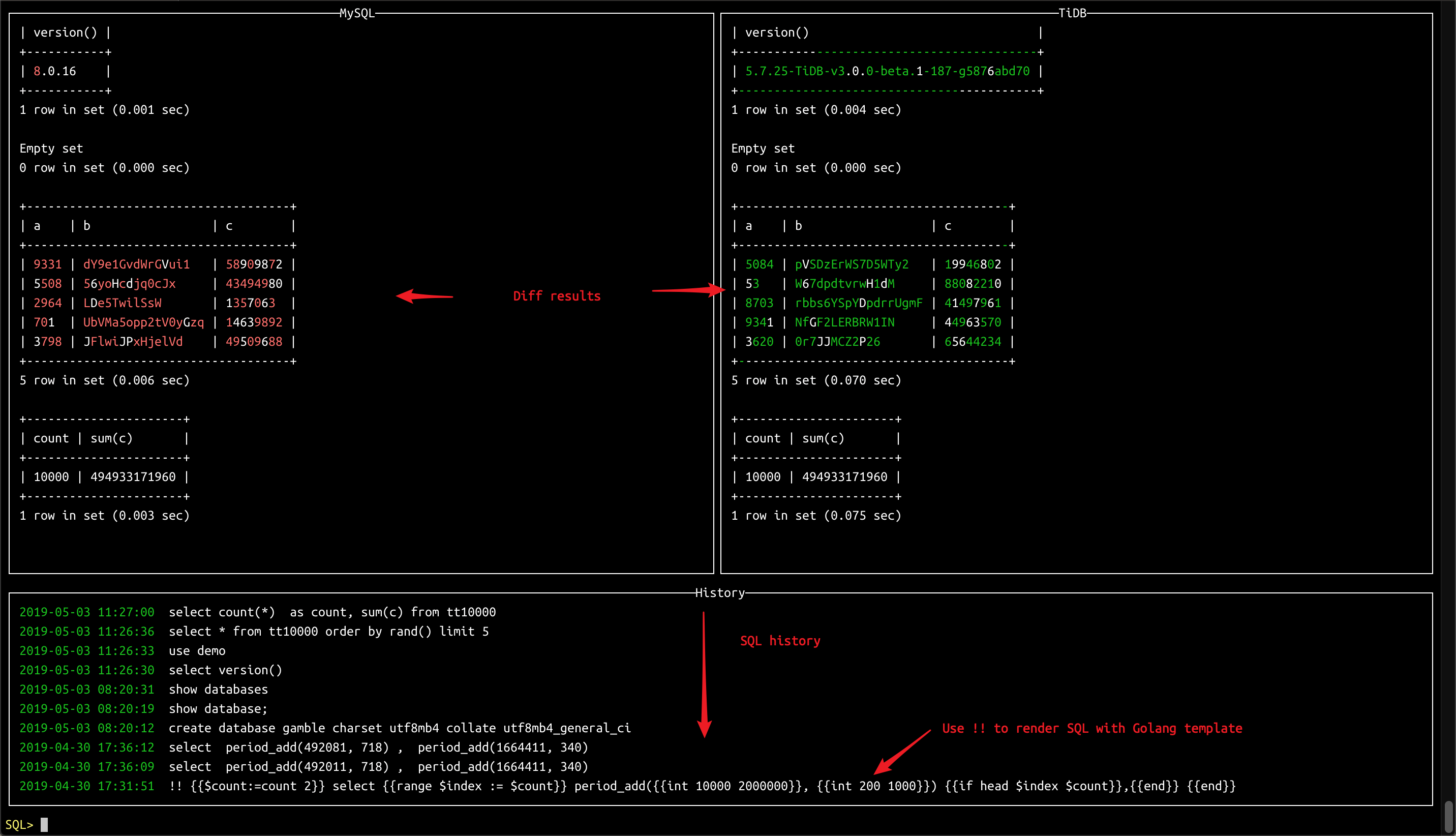tidiff is a diff tool that sends the same SQL statement to TiDB and MySQL for processing, then compares the results and highlights the differences. You can use it in the following scenarios:
-
Checking whether a SQL statement in TiDB is compatible with MySQL
-
Generating the same extra workload for both MySQL and TiDB when it comes to the case that a large amount of data (e.g. 1 million rows of data) is needed to reproduce the BUG.
The examples assume that you have already started the local MySQL and TiDB servers. The servers can be logged in with root username and an empty password.
~ tidiff -h
NAME:
tidiff - Execute SQL in TiDB and MySQL and returns the results
USAGE:
tidiff [global options] command [command options] [arguments...]
VERSION:
0.0.2
DESCRIPTION:
Used to compare the result different in MySQL and TiDB for the same SQL statement
COMMANDS:
help, h Shows a list of commands or help for one command
GLOBAL OPTIONS:
--mysql.host value MySQL host (default: "127.0.0.1")
--mysql.port value MySQL port (default: 3306)
--mysql.user value MySQL username (default: "root")
--mysql.password value MySQL password
--mysql.db value MySQL database
--mysql.options value MySQL DSN options (default: "charset=utf8mb4")
--tidb.host value TiDB host (default: "127.0.0.1")
--tidb.port value TiDB port (default: 4000)
--tidb.user value TiDB username (default: "root")
--tidb.password value TiDB password
--tidb.db value TiDB database
--tidb.options value TiDB DSN options (default: "charset=utf8mb4")
--log.diff value Log all query diff to file
--help, -h show help (default: false)
--version, -v print the version (default: false)
-
Create a
demodatabase for MySQL/TiDBtidiff 'create database demo charset utf8mb4 collate utf8mb4_general_ci' -
Create a
demo.tt10000table for MySQL/TiDBtidiff 'create table demo.tt10000 (a bigint(20) not null auto_increment primary key, b varchar(20) not null, c bigint(20))'or
tidiff --mysql.db demo --tidb.db demo 'create table tt10000 (a bigint(20) not null auto_increment primary key, b varchar(20) not null, c bigint(20))' -
Insert 10,000 rows of data into the
demo.tt10000table using Golang template syntaxtidiff '! {{$count:=count 10000}} insert into demo.tt10000 values {{range $index := $count}} (NULL, "{{varchar 20}}", "{{int 100000 100000000}}"){{if head $index $count}},{{end}}{{end}}' -
Check the number of rows in the
demo.tt10000table and get the sum for columnctidiff 'select count(*) as count, sum(c) from demo.tt10000' -
Select 5 random rows from the
demo.tt10000tabletidiff 'select * from demo.tt10000 order by rand() limit 5' -
Here is the screenshot of the operation above. The result differences are displayed in
diffformat.You can use the command line mode as downstream pipeline, for example
randgen | xargs tididff. The SQL statement should be quote withinstead of.
tidiff provides an interactive mode which records SQL statements execution history so as to run a SQL statement repeatedly.
-
To enable the interactive mode, enter the
tidiff --mysql.db test --tidb.db testwithout a SQL statement. -
If the interactive mode includes
--log.diffparameters liketidiff --log.diff /path/to/diff.log, then all the results are saved into the log file. The difference is also highlighted when you view the results using thecatcommand. -
If a SQL statement that includes some Golang template fails, the error part is highlighted with
/* error message */at the end of the statement. -
Shortcuts for interactive mode
-
SQL Input Panel
-
Use
Enterto execute SQL statements. If a SQL statement begins with!, then Golang template is firstly used, where you can embed statements or expressions that generate random data. If a SQL statement begins with!!, the generated SQL statement appears on the output panel. The SQL statement rendered is not output in the output panel by default. -
Use
TABto switch between panels. -
Use
Up/Dnto fast shift the focus to theHistorypanel.
-
-
MySQL/TiDB Output Panel
-
Use
Up/Dnto turn page up or down. -
Use
TABto switch between panels. -
Use
ESCand return to theSQL inputpanel.
-
-
History Panel
-
Use
Up/Dnto fast shift the focus to theSQL inputpanel. -
Select a history entry and use
Enterto fill it in theSQL inputpanel for later editing and executing. -
Use
ESCand return to theSQL inputpanel.
-
-
Here only introduces usages of :=, range, and if, and the functions provided in tidiff. All SQL statements must start with ! so that tidiff can render them using the Golang template.
-
:=Defines a template variable$rand. The value must be çan integer within the range of10000- 100000.$ tidiff '! {{$rand:=int 10000 100000}} select {{$rand}} < 50000' MySQL(127.0.0.1:3306)> select 78081 < 50000 +---------------+ | 78081 < 50000 | +---------------+ | 0 | +---------------+ 1 row in set (0.001 sec) TiDB(127.0.0.1:4000)> select 78081 < 50000 +---------------+ | 78081 < 50000 | +---------------+ | 0 | +---------------+ 1 row in set (0.003 sec) -
Sample usages for
rangeandif$ tidiff '! {{$counter:=count 5}} select {{range $index:=$counter}} {{int 100 1000}} {{if head $index $counter}},{{end}}{{end}}' MySQL(127.0.0.1:3306)> select 681 , 187 , 147 , 759 , 581 +-----------------------------+ | 681 | 187 | 147 | 759 | 581 | +-----------------------------+ | 681 | 187 | 147 | 759 | 581 | +-----------------------------+ 1 row in set (0.002 sec) TiDB(127.0.0.1:4000)> select 681 , 187 , 147 , 759 , 581 +-----------------------------+ | 681 | 187 | 147 | 759 | 581 | +-----------------------------+ | 681 | 187 | 147 | 759 | 581 | +-----------------------------+ 1 row in set (0.005 sec)Generate 5 random values through Golang template
a. First define a variable as a cycle counter
{{$counter:=count 5}}b. Then use
{{range $index:=$counter}}to traverse$counterc. Output a
,if it’s not the last element of$counteruntil a valid SQL statement is constructed.tidiff '! {{$counter:=count 5}} select {{range $index:=$counter}} {{int 100 1000}} {{if head $index $counter}},{{end}} {{end}}' -
Built-in functions provided by
tidiff-
count n: returns the counter withnelements -
first $index $counter: returnstrueif$indexis the first element of$counter -
last $index $counter: returnstrueif$indexis the last element of$counter -
head $index $counter: returnstrueif$indexis not the last element of$counter -
tail $index $counter: returnstrueif$indexis not the first element of$counter -
int min max: returns an integer within the range of[min, max) -
char length: returns a random string with a length oflength -
varchar length: returns a random string with the length within the range of[length/2, length)
-
tidiff supports saving parameters to the configuration file as key-value pairs. The path of the configuration file is ~/.config/tidiff/config. See the following sample configuration file:
mysql.host = 192.168.4.30
mysql.port = 3306
mysql.user = root
mysql.password = 12345678
mysql.db = test
mysql.options = charset=utf8mb4
tidb.host = 192.168.4.31
tidb.port = 4000
tidb.user = root
tidb.password = 1111
tidb.db = test
tidb.options = charset=utf8mb4

